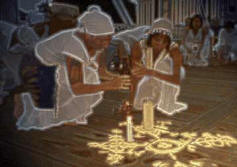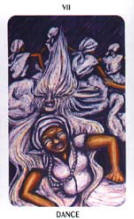|
 Voodoo,
or Vodou is a West African-based religion
of ancestral worship. Voodoo literally
translates to spirit in the Fon
language of West Africa. Thus, worshipping of their
ancestors or the spirits of their
ancestors is the thrust of their religion. Voodoo,
or Vodou is a West African-based religion
of ancestral worship. Voodoo literally
translates to spirit in the Fon
language of West Africa. Thus, worshipping of their
ancestors or the spirits of their
ancestors is the thrust of their religion.
The Voodoo we know of today, arrived
in the West during the slave trading days.
Originating in West Africa, it eventually was
brought over to Haiti when the slaves were brought
over. Voodoo has evolved some because it was mixed
or integrated with Roman Catholicism from the
French plantation owners in the French-occupied
Haiti.
Voodoo is a wonderfully
ceremonial-based religion. Due to both Hollywood and
bigotry, Voodoo's ceremonial ritual have
unfortunately acquired a rather "dark" image. We
usually envision only the black-magic or the lurid
animal sacrifice scenes from what the movies have
shown. For example, although animal sacrifices are
apart of Voodoo, it is actually typical in most
known religions. Black magic does occur as well, but
does not only typify what kinds of rituals
that truly take place. Some people tend towards the
darker element within any religion, be it
Voodoo or Islam or Christianity.
Ceremonies and rituals play a large
part in the practice of Voodoo. Some can include the
following: prayer, dance & music,
animal & blood sacrifice, and spell work:
Prayer
Prayer is an elemental part of a
Voodoo ritual. Prayers are sung, usually in Haitian
Creole. During a ceremony, prayers are sung to
Bon Dieu, or the "good god" and to other gods
or goddesses called Loas or Lwas. They usually open
a ritual with a prayer first to Bon Dieu and their
ancestors and then continue the prayer to a specific
Loa. It is quite familiar to Catholicism and
their saints. In Catholicism, if you need help for
your dear pet, you would prayer specifically to St.
Francis of Assisi, the patron saint of animals.
Voodoo & Roman Catholicism Similarities
 Dance &
Music Dance &
Music
Dancing and music are also major elements of the
Voodoo ceremony. Dancing is an expression of
spirituality, of connection with divinity and the
spirit world. Asagwe is a type of Haitian
voodoo dancing used to honor the gods. The
manman, the largest of the three voodoo drums,
signals for a dancer to start and sets the
distinctive rhythm to which it is performed. The
dance is characterized by sweeping circular
movements, dips, and semi-prostrations.
Avalou Haitian voodoo dances, is
characterized by violent arm and shoulder muscle
movements. Avalou literally means supplication
or to ask humbly and earnestly in prayer.
Animal
Sacrifice & Bloodletting
Animals are actually considered
sacred in African religions and are used as
offerings to the gods and ancestors. Animal
sacrifice has a place in Voodoo ceremonies, but it
is not such a focal point as the movies or books
like to illustrate. The sacrificial animals are
really consecrated offerings, made sacred for
communal meals by the initiate, to share with their
gods, ancestors, and the poor. Such rituals are
common in other world religions such as Judaism or
Islam.
Another ancient Voodoo ritual
involves blood-letting. Using metal knives, members
of the ritual cut their own bodies to release their
blood. In doing so, they are showing how strong
their faith is.
The following link gives an inside
look at a West African Voodoo blood rite:
National Geographic West African Voodoo Blood Rite
Spell Work
Spell work is another form of ritual
to connect to the gods and ancestors. But instead of
dance and music, the needed materials for spell work
can be herbs, oils, candles and other talismans
(dolls, gris-gris). Just like in Wiccan spell work,
spells act as a focus for intentions. It is
important to note that most Voodoo practitioners use
good magic, not the black magic the media is so
ready to promote.
Gris-gris
Please use the following link for a
good source of information on Voodoo and West
African culture:
http://www.npr.org/programs/re/archivesdate/2004/feb/voodoo/
^ back
to top
|

